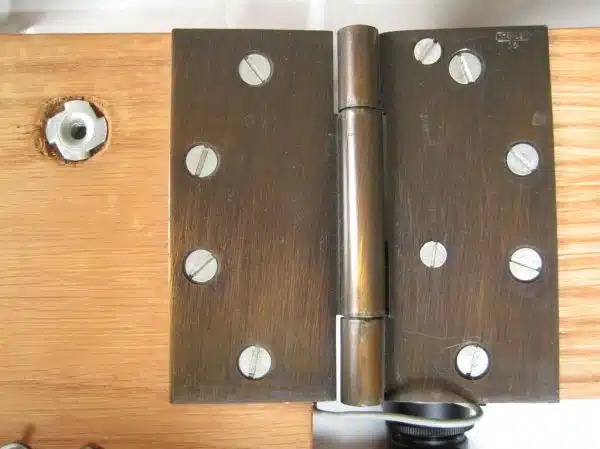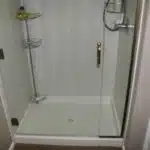Installing door hinges on door blanks is a task that requires precision and attention to detail. It is an essential step in the process of fitting doors, ensuring they open and close smoothly without any issues. As a door hinge installation expert, I understand the importance of correctly installing hinges to ensure long-lasting durability and security.
In this article, I will provide you with a comprehensive guide on how to install door hinges on door blanks. This guide will cover everything from selecting the right hinge size and type to proper placement and alignment techniques. By following these steps, you can ensure that your doors are fitted correctly, providing safety and comfort for years to come.
Gathering The Necessary Tools
Tool recommendations and safety precautions are important aspects of installing door hinges on door blanks. Without the proper tools, the installation process can be difficult and frustrating. Therefore, it is necessary to gather all the necessary tools before starting the installation process.
When it comes to tool recommendations, a few essential items are required for this task. Firstly, you will need a drill machine with a suitable drill bit for making pilot holes in the door blank. Additionally, ensure that you have screwdrivers (preferably electric) that fit the screws tightly. A hinge jig or template is also helpful as it ensures precise drilling of holes on both sides of the door blank.
Safety precautions should not be overlooked when installing door hinges on door blanks. It is crucial to wear protective gear such as gloves and goggles to prevent injuries from flying wood chips or metal shavings during drilling or screwing. Moreover, ensure that your work area is well-lit and free from any tripping hazards to avoid accidents while working with power tools.
With these tool recommendations and safety precautions in mind, you are now ready to get started on selecting the right hinge size and type for your door blank installation project.
Selecting The Right Hinge Size And Type
It is essential to select the appropriate size and type of hinge for your door blank. Choosing the wrong size or not understanding the hinge weight capacity can lead to issues with the door’s functionality and durability. It is crucial to select a hinge that can support the weight of your door and withstand regular use.
When selecting a hinge, it is also important to consider its finish. Hinges are available in various finishes, including brass, chrome, nickel, and black. The finish you choose can impact the overall appearance of your door, so it is crucial to select one that matches your preferences and complements your home’s interior design.
Understanding hinge weight capacity is vital when choosing a hinge for your door blank. The weight capacity determines how much weight the hinge can hold safely without causing any damage or affecting the door’s ability to open and close correctly. Be sure to choose a hinge with a higher weight capacity than necessary for added safety and durability.
Now that you have selected the appropriate size and type of hinge for your door blank, it’s time to prepare it before installation. To ensure proper installation, you must first prepare your door by measuring where you want each hinge placed accurately. This measurement will help determine where you need to drill pilot holes for screws during installation without compromising its functionality.
Preparing The Door Blank
Before installing door hinges on a door blank, it is essential to prepare the door blank properly. One of the first steps in preparing the door blank is to measure it accurately. Measuring techniques may vary depending on the type of hinge being used and the size of the door. It is always best to consult manufacturer guidelines to ensure that you are measuring correctly.
After measuring, sanding the door blank is important. Sanding will ensure that the surface of the door blank is smooth and even, allowing for a secure attachment of the hinges. Use fine-grit sandpaper and sand in a uniform direction, being careful not to over-sand any one area. After sanding, clean off any dust or debris from the surface before moving on to marking out where to place your hinges.
Preparing your door blank effectively will guarantee that your hinge installation will be successful. The next step after sanding is marking the hinge placement. This step requires precision and accuracy as any deviation can cause issues with how well your hinges operate once installed. With proper preparation, accurate measurements, and perfectly sanded surfaces, marking out where to place your hinges should be straightforward and easy.
Marking The Hinge Placement
Like a painter with a blank canvas, the door hinges are the finishing touches that complete the door. Before installing them, it is crucial to ensure accuracy in measurements to avoid any mistakes that could lead to costly repairs. In this section, we will discuss how to mark the hinge placement correctly and how to avoid common mistakes.
Measuring accuracy is key when installing door hinges. A small error in measurement can cause significant problems later on, such as misalignment or inability to close or open the door correctly. To ensure accuracy, use a measuring tape and make precise measurements for each hinge placement, ensuring they are level with each other. Also, mark where the screws will go for each hinge before drilling to avoid confusion later.
There are several common mistakes to avoid when installing door hinges. One mistake is placing the hinges too far away from the edge of the door, which can cause instability and difficulty in opening and closing the door. Another mistake is not making sure that both sides of the hinge line up precisely with each other on both sides of the door frame. Ensure proper alignment by using a straightedge or leveler before screwing in place. By avoiding these common mistakes, you can create a solid foundation for your door hinges and ensure smooth operation for years to come.
Transition: Now that we have marked our hinge placements accurately and avoided common mistakes, our next step is creating mortises for the hinges.
Creating Mortises For The Hinges
To properly install door hinges on door blanks, the creation of mortises is a crucial step. Before starting this process, it’s important to understand the different types of door hinges that are available. The three most common types are butt hinges, continuous hinges, and pivot hinges. Butt hinges are the most commonly used option and require a mortise to be cut into both the door and frame. Continuous hinges run the full length of the door and typically only require one mortise on the frame side. Pivot hinges are often used for specialty doors and swing on a single pivot point.
When it comes to creating mortises for door hinges, there are a few alternative installation methods that can be considered. One option is using a router with a hinge template to ensure precise cuts. Another method involves using a chisel and hammer to manually carve out the mortise. Regardless of which method is chosen, it’s essential that the depth of the mortise matches that of the hinge leaf thickness.
It’s important to note that while creating mortises for door hinges may seem straightforward, mistakes can easily be made if proper care isn’t taken. It’s recommended to practice on scrap pieces of wood before attempting to install on an actual door blank. In addition, always double-check measurements and use appropriate safety gear when working with tools such as routers or chisels. With these precautions in mind, you’ll be able to successfully create mortises for your chosen type of hinge in preparation for installation onto your door blank.
Chiseling Out The Mortises
As the saying goes, “measure twice, cut once.” This applies to chiseling out mortises for door hinges. It is crucial to take accurate measurements before beginning the chiseling process. This step ensures that the hinges fit snugly into the door and align properly with the frame.
Using a router is an efficient method for creating mortises in door blanks. However, not everyone has access to this tool. In such cases, alternative methods can be used. One such method is tracing around a hinge with a sharp pencil or utility knife and then using a chisel to remove the wood within the traced area. Another alternative is using a drill to create multiple holes within the traced area and then chiseling out the remaining wood.
Troubleshooting common issues when chiseling out mortises can save time and effort. Common issues include splitting of wood, uneven depths of mortises, and hinge misalignment. To avoid splitting of wood, use a sharp chisel and make shallow cuts at first before proceeding deeper. To maintain even depths of mortises, use a depth gauge or mark depth lines on your chisel blade with tape or marker. In case of hinge misalignment, check if both sides of the hinge are level before continuing with installation.
As you finish up with creating perfect mortises for your door hinges, it’s now time to secure them in place on your door blank.
Securing The Hinges To The Door
Accurately measuring the door blank for the placement of the hinges is an important step in the door hinge installation process. A door hinge installation expert should use a tape measure to determine where the hinge holes should be drilled. Drilling the hinge holes is the next step and requires the use of a drill with a spade bit device. An experienced door hinge installation expert should make sure the hinge holes are drilled vertically and to the proper depth.
Measuring For Hinge Placement
Proper hinge placement is crucial for the smooth operation of a door. Measuring accuracy is essential to ensure that the hinges are properly aligned, preventing common mistakes that can lead to uneven doors or difficulty in opening and closing. To measure accurately, start by placing the door on a flat surface and measuring its height and width. Take note of any irregularities such as warping or bowing that may affect the alignment of the hinges.
Next, determine the number of hinges needed based on the door’s weight and size. Heavy or oversized doors require at least three hinges evenly spaced along the length of the door. Measure and mark where each hinge will be installed, ensuring they are level with each other and centered on the thickness of the door blank. Double-check your measurements before drilling pilot holes for each hinge.
One common mistake when installing hinges is not measuring accurately or not aligning them correctly with one another. This can cause binding or uneven doors, which can be frustrating and costly to fix later on. By taking proper measurements and paying attention to alignment detail, you can avoid these common mistakes and ensure a successful installation outcome every time. Remember, accuracy is key in securing hinges to door blanks so take your time and always double-check your work before proceeding with installation.
Drilling Hinge Holes
Properly securing the hinges to the door is crucial for ensuring that the door operates smoothly. One common mistake when securing hinges is not drilling hinge holes accurately, which can lead to binding or uneven doors. To avoid this mistake, it is important to take accurate measurements and double-check your work before drilling.
Before drilling hinge holes, mark where each hinge will be installed and ensure they are level with each other and centered on the thickness of the door blank. Use a drill bit that matches the size of the screws for your hinges and drill pilot holes at each marked location. When drilling, make sure to keep the drill perpendicular to the surface of the door to prevent angled holes that may cause binding.
If you encounter any issues while drilling hinge holes, there are troubleshooting tips you can use to correct them. For instance, if a hole is too large, fill it with a wooden dowel coated in wood glue and let it dry before re-drilling. If a hole is too small or off-center, use a chisel or sandpaper to adjust its size and position as needed. By taking proper precautions and correcting any issues as they arise, you can ensure that your hinges are securely attached to your door for optimal operation.
Aligning The Hinges
To properly install door hinges on door blanks, it is crucial to take the time to align them correctly. Failure to do so can result in a door that is difficult to open or close, and may even cause damage to the hinges themselves. One of the most common mistakes made during hinge alignment is failing to ensure that they are level with each other. This can result in one side of the door being higher than the other, which can lead to improper operation.
To avoid this mistake, start by measuring and marking where each hinge should be placed on the door blank. Then use a level to ensure that both hinges are perfectly straight and level with one another. It may also be helpful to use shims or wedges as needed to make small adjustments before attaching the hinges.
If you find that your hinges are not lining up correctly despite your best efforts, there are several troubleshooting tips you can try. First, double check your measurements and markings for accuracy. If they are incorrect, adjusting them could solve the problem. Another option is to consider purchasing adjustable hinges which allow for more flexibility in alignment. Finally, if all else fails, seek advice from a professional installer who can offer expert guidance.
When you have successfully aligned your hinges, it is important to check for proper clearance between the door and frame. To do this, open and close the door several times while observing how it moves in relation to the frame. Make any necessary adjustments until you achieve smooth operation without rubbing or scraping against the frame or jamb. With careful attention paid during alignment and troubleshooting when necessary, your newly installed hinges will provide years of reliable service for your doors.
Checking For Proper Clearance
Now that the hinges have been aligned properly, it is time to check for proper clearance. Measuring clearance is an important step in door hinge installation because it ensures that the door opens and closes smoothly without any obstructions. To measure clearance, place a piece of cardboard or paper between the door and the frame and close the door. If there is resistance or if the paper/cardboard gets crumpled, then adjustments need to be made.
Adjusting hinge placement may be necessary if there is not enough clearance between the door and frame. Use a chisel to create more space for the hinges if needed. It’s important to make sure that each hinge is at exactly the same distance from both sides of the door before screwing them into place. This will prevent any uneven stress being placed on one side of the door causing it to warp over time.
Properly installing hinges can be a frustrating task for those who are inexperienced with DIY projects; however, with patience and attention to detail, anyone can complete this task with ease. The key takeaway from this section is that measuring clearance and adjusting hinge placement are crucial steps in ensuring your door operates effectively over time. Next, we will move onto preparing the door frame for receiving the hinges.
Preparing The Door Frame
Once you have your door blank ready, it’s time to prepare the door frame for hinge installation. The first step is to measure the thickness of the door blank and compare it with the depth of the hinge mortises in the frame. This can be done using measuring techniques such as a vernier caliper or a ruler. If there is any discrepancy, adjustments must be made either to the hinges or to the mortises.
Next, check for any rough spots or protrusions on the frame that might prevent proper installation of the hinges. These can be removed using sanding techniques such as using a sandpaper block or an electric sander. Make sure to sand evenly and avoid over-sanding as this can cause deformations in the frame.
As a door hinge installation expert, I always stress on taking these preparatory steps seriously as they are crucial for ensuring smooth operation of the door. Once you have checked and adjusted the dimensions and shape of the frame, it’s time to move onto marking the hinge placement on the frame.
Marking The Hinge Placement On The Frame
After preparing the door frame, the next step in installing door hinges on door blanks is marking the hinge placement on the frame. This is a crucial step that requires precision to ensure that the door functions properly. To accurately mark the hinge placement, first position the door blank in the frame and mark where each hinge will be placed. Use a pencil to draw a straight line across both the door edge and frame at each hinge location.
Tips for ensuring proper alignment of door hinges on the frame include using a level to ensure that the hinges are aligned vertically and horizontally. The level should be placed against each hinge bracket to make sure that it is straight. Additionally, use shims to adjust any gaps between the frame and door if needed. It is also important to measure and mark where the screws will go, making sure they are evenly spaced and not too close to the edge of either the frame or door.
After marking out where each hinge will be placed, it’s time to create mortises for them on the frame. Mortises allow you to recess your hinges into your door’s edge, providing a clean look while ensuring that your hinges remain securely attached over time. Creating mortises for your hinges involves carving out space in your wood so that they fit flush with your surface. This can be done using various tools such as chisels or specialized jigs designed specifically for creating mortises in wood frames.
Creating Mortises For The Hinges On The Frame
To create mortises for the hinges on the frame, one effective technique is to use a router. A router is a motorized tool that can cut precise and clean mortises of various depths and widths. To begin, measure and mark the locations for the hinges on both sides of the door frame. Then, attach a guide fence to the router base to ensure straight and accurate cuts. Adjust the depth and width of the router bit according to the size of your hinges. Start from one end of the hinge location and gradually move towards the other, taking care not to overlap or over-cut.
Despite its convenience, using a router for mortising can also lead to some common mistakes if not done properly. One such mistake is cutting too deep, which can weaken or break through the edge of the frame. To avoid this, always measure and mark your desired depth before starting to cut with the router. Another mistake is cutting too wide or unevenly, resulting in loose or misaligned hinges. To prevent this, use a sharp bit and make several shallow passes instead of one deep pass.
In addition to these troubleshooting tips, it’s important to take safety precautions when using a router or any power tool. Always wear eye protection, ear protection, dust mask, and gloves as necessary. Keep your hands away from moving parts and never force the tool beyond its capacity. With proper technique and attention to detail, using a router for mortising can be an efficient way to create neat and precise hinge slots on your door frame.
Having created mortises for your hinges with a router, you are now ready for chiseling out the mortises on the frame itself with precision tools such as chisels and mallets. This step requires more manual labor but allows you greater control over shaping and fitting each hinge slot exactly to its respective hinge leaf. Let’s discuss this next step in more detail below.
Chiseling Out The Mortises On The Frame
The next step in installing door hinges on door blanks is chiseling out the mortises on the frame. The mortise is a recess or slot cut into the frame where the hinge plate will be inserted. This step requires precision and accuracy to ensure that the hinge plate fits perfectly into the mortise.
Tips for accuracy during this step include using a sharp chisel, taking your time, and making small cuts rather than trying to remove too much material at once. Measure carefully and mark out the mortise with a pencil or knife before starting to chisel. Common mistakes to avoid include cutting too deep or at an angle, which can cause the hinge plate to sit unevenly, and not making sure that the mortise is deep enough for the entire hinge plate.
Once you have chiseled out both mortises on the frame, test fit each hinge plate to make sure it sits flush and level. If adjustments are needed, use a file or sandpaper to smooth out any rough edges or high spots. When both plates fit snugly in their respective mortises, move on to securing them to the frame.
- Use a sharp chisel
- Take your time and make small cuts
- Measure carefully and mark out the mortise before starting to chisel
- Test fit each hinge plate before moving on
With the mortises properly cut and tested for accuracy, securing the hinges to the frame is next.
Securing The Hinges To The Frame
- Accurate measurements of the frame are essential to ensure the door hinges fit correctly.
- Once the correct measurements have been taken, the hinges must be marked for the most precise installation.
- When attaching the hinges to the frame, screws should be used for the strongest hold.
- Drilling pilot holes prior to screw installation helps to ensure the screws are driven into the frame without damaging the surrounding material.
Measuring The Frame
As a door hinge installation expert, I understand the emotional investment that homeowners put into their doors. To ensure proper installation of door hinges, precise measurements of the frame are essential. Common mistakes during this step can lead to misaligned or unevenly spaced hinges, which can result in difficulty closing or opening the door.
To avoid these mistakes, start by measuring the door’s height and width with a tape measure. Measure from the top of the frame to the floor for height and from side to side for width. Next, determine where you want to place your hinges on the frame. A standard three-hinge placement usually works best. Measure equal distances between each hinge and mark them with a pencil.
For accurate measurements when installing door hinges, it is crucial to take into account any irregularities in the frame or door blank. Check for any warping or bowing in both components before taking measurements. Finally, double-check all measurements before drilling holes for hinge screws. Taking these tips into consideration will help secure your hinges properly and ensure smooth operation of your door for years to come.
Marking The Hinges
Now that we have covered the importance of taking precise measurements for the frame, let’s move on to marking the hinges. After determining where to place the hinges on the frame, it is essential to mark them accurately. Using a hinge jig can help ensure proper hinge spacing and alignment. A hinge jig is a tool that attaches to the frame and guides where to drill holes for the screws. This ensures that all hinges are aligned correctly and evenly spaced.
When marking the hinges, it is crucial to use a pencil instead of a pen or marker. Pencils allow for easy erasing if mistakes are made during installation. Mark each hinge’s location on both the door blank and the frame using a level tool to ensure they are straight. Double-check all markings before drilling any holes.
Properly marking your hinges is an integral part of securing them onto your door frame correctly. Taking care in this step will help prevent misaligned or unevenly spaced hinges, making opening and closing your door easier in the long run. Remember always to double-check your measurements before drilling any holes and use a hinge jig for proper spacing and alignment.
Testing The Door For Smooth Operation
After securing the hinges to the frame, the next step is to install them on the door blanks. Begin by placing the door on a flat surface and marking where the hinges should be installed. It is important to ensure that both sides of the door are even before proceeding with hinge installation. Once you have marked the location of the hinges, use a drill bit that matches the size of your screws and create pilot holes for each hinge.
After creating pilot holes, place each hinge in its respective location and fasten it using screws. Check hinge alignment by closing and opening the door several times. If there are any issues with alignment, adjust the position of the hinges until they align properly. If you encounter any problems during installation, refer to troubleshooting common hinge installation problems.
Common problems include doors that do not close properly or are difficult to open or close. This can be caused by misaligned hinges or poorly fitting door blanks. To troubleshoot these issues, first check that all screws have been tightened properly and that there are no loose fasteners. Next, double-check that all hinges are aligned correctly and adjust as needed. If none of these steps solve your problem, it may be necessary to replace one or more components of your door assembly.
Checking hinge alignment and troubleshooting common installation problems is crucial for ensuring a smooth operating door system. With proper installation techniques and attention to detail, you can enjoy a functional and aesthetically pleasing door for years to come without encountering issues commonly associated with poor hinge installation practices.
Conclusion
The installation of door hinges on door blanks is a critical process that requires attention to detail and proper execution to ensure the longevity and smooth operation of the door. As a seasoned hinge installation expert, I have outlined the necessary steps for successfully installing door hinges on door blanks.
After gathering the necessary tools and selecting the right hinge size and type, it is important to prepare the door blank by marking the hinge placement and creating mortises for both the hinges on the door and frame. Chiseling out these mortises on both surfaces will allow for secure attachment of the hinges, ensuring that they are properly aligned with each other.
Finally, securing the hinges to the frame should be done with care to avoid any damage during installation. Once complete, testing the door for smooth operation is crucial in ensuring its functionality. Overall, following these steps will guarantee a successful hinge installation that will provide long-lasting function and durability. As Aristotle once said, “Excellence is never an accident. It is always the result of high intention, sincere effort, and intelligent execution.”
Image Credits
- “Astrokits Quartz Stepper Barn Door camera platform (Hinge)” by distar97 (featured)





























